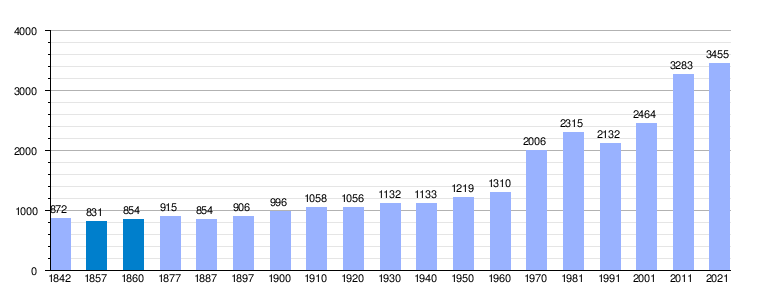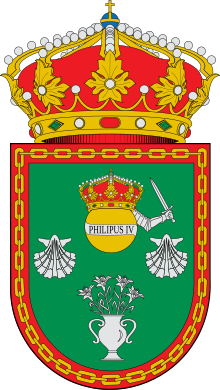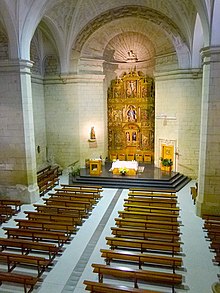Oyon
Oyón (in Basque Oion and officially Oyón-Oion) is a Spanish municipality in the province of Álava, in the autonomous community of Basque Country. In 2019 it had a total of 3,386 inhabitants. It is part of the metropolitan area of Logroño, whose city is 3 kilometers away.
Geography
Territorial organization
Councils
- Barriobusto (officially Barriobusto/Gorrebusto)
- Labraza
Locality
- Oyón (officially Oyón/Oion), capital of the municipality.
History
In the history of Oyón we must highlight a series of important events that are represented in the heraldic shield of the town. They are the following:
- The very long stay of Oyon, in the old kingdom of Navarre as a village dependent on the village of Laguardia (923-1461). It appears in 1366 as a village dependent on Laguardia, whose brotherhood belonged to, in the attachment that took place in that year of the villages of Navarre.
- The longest dependency of Oyón del Obispado de Pamplona -o de Nájera- (923-1862).
- In 1461 Enrique IV de Castilla conquered the sound of Navarre (now Rioja alavesa), the town had a strong house, but the historical defenses were given in the fortress of Laguardia. It was a decisive region, since 50 years later the definitive incorporation of Navarre occurred in 1512.
- The union of Oyon as part of the City of Laguardia to the Brotherhood of Álava in 1486, 23-25 years after the conquest of Oyón by Castile.
- In 1633, thanks to a real privilege of Felipe IV, he became independent of Laguardia and became Villa.
- Having been an important milestone in the first itinerary of the Camino de Santiago, at least until 1095.
- By resolution of 20 January 1992 of the Basque Government, the villa is officially named Oyón-Oion.
Demography
It has a population of 3,408 inhabitants (INE 2022).
| Graphic of demographic evolution of Oyon-Oion between 1842 and 2021 |
 |
Before 1988 it was called Oyon
|
Symbols

The heraldic shield that represents the municipality was officially approved on September 25, 1992 with the following blazon:
"I listen: in the field of siple (green), in chief a globe of the world of gold with a silver band that contours it, with the inscription PHILIPUS IV, and crowned by a royal crown; coming out of its left side an arm armed with silver holding a sword; on the tip a jar of silver blues; accompanied all by two royal silver worships one on each side; orchard: a chain of silver. »Official Gazette of the Basque Country No. 207 of 23 October 1992
Administration and politics






| Political party | 2015 | 2011 | 2007 | 2003 | 1999 | 1995 | 1991 | |||||||
|---|---|---|---|---|---|---|---|---|---|---|---|---|---|---|
| Popular Party of the Basque Country (PPP) | 35.27 % | 4 | 41.72 % | 5 | 25.95 % | 3 | 34.69 % | 4 | 25.84 % | 3 | 23.1 % | 3 | 23.06 % | 3 |
| Eusko Alderdi Jeltzalea - Basque Nationalist Party (EAJ-PNV) | 33,98 % | 4 | 30.11 % | 3 | 49.89 % | 6 | - | - | - | - | 35.12 % | 5 | 33.11 % | 4 |
| Euskal Herria Bildu (EH Bildu) / Bildu | 15.68 % | 2 | 15.31 % | 2 | - | - | - | - | - | - | - | - | - | - |
| Euskadi-Euskadiko Ezkerra Socialist Party (PSE-EE) | 8.79 % | 1 | 10.04 % | 1 | 19.93 % | 2 | 17.83 % | 2 | 11.17 % | 1 | 12.45 % | 1 | 15.06 % | 2 |
| Gure Herriak Oion Labraza Gorrebusto (GUM)日本語 | 4.64 % | 0 | - | - | - | - | - | - | - | - | - | - | - | - |
| Aralar | - | - | 1.38 % | 0 | - | - | - | - | - | - | - | - | - | - |
| Ezker Batua-Berdeak (EB-B) | - | - | - | - | 3.3 % | 0 | 3.37 % | 0 | 6.72 % | 0 | 10.64 % | 1 | - | - |
| Basque Nationalist Party/Eusko Alkartasuna (PNV/EA) | - | - | - | - | - | - | 42.74 % | 5 | 43.87 % | 6 | - | - | - | - |
| Alavesa Unit (UA) | - | - | - | - | - | - | 0.69 % | 0 | 3.14 % | 0 | 5.36 % | 0 | 5,87 % | 0 |
| Euskal Herritarrok (EH) | - | - | - | - | - | - | - | - | 8.47 % | 1 | - | - | - | - |
| Herri Batasuna (HB) | - | - | - | - | - | - | - | - | - | - | 8.04 % | 1 | 11.49 % | 1 |
| Eusko Alkartasuna (EA) | - | - | - | - | - | - | - | - | - | - | 4.56 % | 0 | 8,09 % | 1 |
| Euskadiko Ezkerra (EE) | - | - | - | - | - | - | - | - | - | - | - | - | 2.13 % | 0 |
Heritage
- Church of Saint Mary of the Assumption: Temple in sillery built in baroque style during the centuryXVIII (1744-1748), on one previous of the last years of the centuryXV or principles of XVI at the end of the Gothic, construction of which there are few remains. The isabeline Gothic-Renaissance Cover of the XV-XVI, with fine polylobed arc works. The choir is Plateresque, XVI. The apse is semicircular, divided into four sections by the counters. The main Renaissance altarpiece with advances of the baroque, of very good bill. The baroque tower is considered to be the most slender and well-drawn of Rioja Alavesa. It is known as the "Giralda", a name that takes from the sailboat that the crown (figure of hilander with its wheel and its rueca).
- The Body: The organ was inaugurated on April 29, 1995, has been designed by José Antonio Santos of the Church, is the most modern organ in Álava. Highlights for having very special features like “peculiar sound projection to space“that emanates the instrument, because each of its elements is a different body. It follows the style called Nordic (North Europe) that prevailed in Northern Germany at the end of the year.XVII, influenced by the characteristics of the German organs, has pedals.
- Hermitage of the Virgin of the Vineyards: It is located on the mountain and park of Saint Mary. It's a modern construction, 1993.
- Palace of the counts of Bureta: It stands out with brick tower and four arches blinded on each side. (Special property).
- Palace of the Marquis del Puerto: Next to the church, the proud Palace with soft and legend. (Special property).
Festivals and traditions
- The Aurora of Kings: on January 6, the Day of Kings the young people of the village come out early to sing through the streets of the village some songs of religious inspiration called auroras. They meet at 4 a.m. and sing in the corners where the municipal bands were formerly published. The lyrics and music of each aurora are used only once.
- The Patron Festivals of Oyon are held on 21 and 22 January (San Vicente and San Anastasio). There are numerous acts and traditions during these holidays (Katxi, bonfires, aurora, dance, torillo de fuego).
- Katxi Round: The Katxi or Cachi is the central character of these parties. Of unknown origin, it is a kind of buffet with a felt suit of large red and green stripes, which is touched with a cap of equal cloth and carries a fox skin. There are written mentions of the end of the centuryXVIIThat they mention it as "Bobo". Walk the village, in front of the band of music both on 21 and 22 and perform several times a dance rolling down the ground under the municipal flag, as they are of a traditional music.
- Hogueras or Marches: this tradition goes back to the bonfires that were lit through the streets of the town to light them during the night. On 21st, the eve of those in Oyon Square.
- Aurora de los Patronos: on the 22nd at 4h the aurora is celebrated. Like the Day of Kings the "auruses" leave early to sing, this time in honor of the patrons. Unlike the 6th day, the Aurora de los Patronos participates the elders instead of the young.
- The dance of the patron saints: after the Mass of the 22nd day a procession of the saints is celebrated. Eleven dantzaris, arranged in two rows of five, with the captain director, perform the dance to the son of the gaita and drum (circuentially, clarinet and box) and tañendo las castañuelas. Two are the versions and both alternate in the four equidistant points of the procession: in one of them, composed of four parts, the dantzaris alternate crosses, chains and turns in the air, to offer a beautiful, colorful and complicated dance. In the other, which is similar to the first part of the previous one, dances advancing from behind to the sense of the march, and in front of the Holy Patrons.
- Fireplace: During the procession, on a fireworks wheel, the events occurred on January 22, unknown year. “Many years ago on St. Vincent and St. Anastasio’s day, while the procession of the Holy Patrons was celebrated, one of the recesses that were going to be dealt with in the afternoon celebration escaped from the corrals. Faced with the presence of the animal, the Oyones who participated in the procession held static, entrusting themselves to their Patrons and the animal far from snatching against them fell down before them without anyone suffering any harm.” As a reminder of this event, the burning of the “torillo that includes a artificial fireworks column placed in a mast located in the square dedicated to Saint Vincent and San Anastasio is included in the procession. Wheel of artifice fires on which a bull and a countryman are placed.
- Giants and Cabezudos: Giants: -Pareja de Rey y Reina that represent the Kingdom of Navarra to which Oyón belonged. -Pareja de Hombre y Mujer regional Vascos. Cabezudos: -Demon, Navarrico, Aldeano and Aldeana. This squad makes the delights of young and old with their raisins and dances to the son of the charanga or gaiteros at the patron saints' feasts of Saint Vincent and St. Anastasio, where they accompany the procession, in Saint Prudencio (28 April) and Thanksgiving Festivals (August).
- Resurrection Sunday. (act: burning of the Judas).
- ' San Prudencio:' the day of the pattern of Álava is celebrated a Tamborrada.
- Thanksgiving Festivals are the summer holidays and are celebrated since 1948. Since 1979 the holidays begin on Wednesday prior to the last Sunday of August with the Katxi Fall, inspired by the Celedon and close the weekend with the increase of the doll. Among the activities of the festivals are enclosures, tastings, cyclist race, verbs, giants and scalps, toro de fuego, etc.
Gastronomy
- Meals: garlic soups and chorizo, potatoes with chorizo or the riojana; vegetable minstre, ranch (Labraza), pan migas to the skillet (Oyón), sausage chops, roast lamb.
- Sweets: sob cakes, garrapiñadas almonds, torrijas, buñuelos, cosquillas, rice with milk, compota of dried figs, Katxi pie (Oyón).
- Drinks: rice, tostadillo (Oyón), Zurracapote, wines, cava.